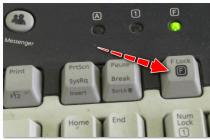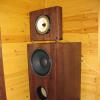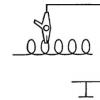Broadband speakers are acoustic systems in which an electrical signal is fed to the speaker without first dividing into frequency bands - LF and HF. At the very beginning of the era of sound reproduction, almost all speakers had high sensitivity and were wideband. With the development of sound reproduction technology, the design of speakers with one speaker responsible for the entire sound spectrum was replaced by a system in which the sound was divided into two bands by a special device - a crossover. In such speakers, individual speakers of different designs, materials and different mass dimensions "served" their individual sub-range. The lower speaker with a larger cone area and density was responsible for the low frequencies and mids, and the upper one for the treble. With the development of acoustic systems, the fragmentation of sound into strips continued, and speakers with three, four and even five sound strips began to appear - they began to be called. If you follow the definition exactly, then broadband speakers in their pure form are found today only in "radio hotspots", but marketing has made its own adjustments, and today many speakers fall under the definition, which in the strict sense are not broadband - they are TWO-BAND. The signal is divided in them by a crossover into two bands and fed to two speakers of different designs - the upper speaker is responsible for the treble, the lower one for the bass and midrange. At the same time, there are other speaker systems in which there are also two bands and two speakers, but no one calls them broadband. Where is the truth?
In order not to confuse readers, it seems to me that the modern definition of "broadband acoustics" should be given precisely from the marketing, not the technical side. Moreover, from the technical point of view, it is already given at the beginning of the article.
A wide-range speaker system today is usually a floor-standing or large bookshelf speaker with no more than two high-sensitivity speakers. The speaker responsible for bass and midrange is equipped with a light thin cone of a large area, most often made of paper. He is responsible for reproducing most of the sound spectrum of music - from drums to vocals. The speakers responsible for the treble also differ in a significant area - they are smaller than the low-frequency ones, but you will not see any "tweeters" with a metal diffuser the size of a penny in broadband speaker systems.
Lightweight cones of full-range speakers are able to convey the subtlest nuances of music - vocals overtones, the lightest string plucking. When you listen to broadband acoustics with a good reproduction path, it seems that you can hear the rosin crumbling from the violinist's bow. The wideband acoustics are ideal for reproducing classical and light live music, and for this they are deservedly loved by many audiophiles. The best full range loudspeakers I have heard were based on LOUTHER speakers. You can listen and order them

UNIVERSO VIRTUOSO speaker systems by Alexander Chervyakova (www.tube-eden.ru) are classic broadband acoustics. However, at first glance, it is clear that these are still two-way speakers.
______________________________________________________________
Alexander himself will tell you more about these acoustic systems:
"Long ago I was lucky to hear the correct" open baffle "
in English) acoustics on the right speakers in the right room. I have remembered this sound for the rest of my life. It is impossible to imagine anything more natural, light, musical. There is no shamanism or isotericism here - the speakers simply work without experiencing any pressure from the rear side on the diffuser and, as a result, we have such an open, light and airy sound. Because the speaker emits sound from the opposite side, additional volume is created, the atmosphere of a studio or a concert hall is very well conveyed,
additional overtones appear, cat. cannot be heard in any other design. Unfortunately, in this life you have to pay for everything. It’s not for nothing that I mentioned the word “correct” three times. To get more or less decent woofers, the speaker must be at least 12 ", and the shield is very large. But most importantly, the room must be large too! You can't put such acoustics close to the walls. Min. 2-3 meters from the walls. This completely kills this idea in our reality. True,
there are "enthusiasts" who are not burdened with either experience or knowledge, and put the first speakers they come across in shields, such as "door" and pruzza. Let's leave this happiness to them, and we ourselves will go the other way ...
Concept.
1. Because my favorite and, in my opinion, the best amplifier has a max. power is only 2W, total. the sensitivity of the acoustics should not be
less than 95-96dB / W. This will make it possible to comfortably listen to music with only 0.5W of power in a room of 20-30m2.
2. Acoustics should sound in rooms of any reasonable size (15-60m2).
3. Mid and high frequencies should be played out by one full-range speaker in "open baffle" design. The speaker should be very musical and balanced.
4. ShP section should move freely in all directions to select the optimal position.
5. A separate section should be responsible for the bass. Necessarily at least 12 ". An ideal" stitching "between LF and WB is required. The filter should be the simplest 1st order. The crossover frequency should be within 100-200Hz. This is possible only with the correct and successful choice of the woofer. The speaker should be sensitive not less than 96-97 dB / W.
6. The ability to quickly adjust the level between LF and SHP for personal and genre preferences.
7. Unusual design and finish. Do not use varnishes that give the appearance of a cheap laminate to natural veneer. Give preference to waxes and oils. Possible "zakos" for vintage.
Design.
Everything that is listed in the concept was implemented in the final design. The most difficult, expensive and tedious choice was the choice of the woofer. The modern industry has completely switched to the production of dull, heavy, long-stroke, low-sensitivity, dreary-sounding woofers. The broadband speaker is very fast and lightweight and it seemed impossible to me, in general, to find the same bass. But the miracle happened. I managed to find a very fast and lightweight paper one with a fabric suspension, a cat. does not lag behind the ShP. It is important that it does not have a giant "overshoot" at the end of its operating range, which is usual for low-frequency speakers, so it turned out to be possible to "cut" it with the simplest filter on one coil. Speaker 12 "(30cm),
American Eminens. Body with a volume of 150 liters, bass reflex design.
SHP- Audio Nirvana, 6.5 ", also USA. Very musical and balanced. The filter for it is the simplest 1st order on the Sollen film condenser." Purists "can easily refuse it, removing the phase mismatch by the correct location of the SHP section on the body
LF. ShP has a level regulator. Its idea is this: do you want to add gas on rock or
Electronically, squeeze the ShP and add power with the amplifier. You will be blown off the chair by two correct
12 "woofer in the right bass design. Bass drum will delight you.
Finish - veneer, waxed. Any veneer is possible. In my case, it is an oak tree.
Sound.
It makes no sense to describe it. You have to listen. The sound is unusual. It has nothing to do with modern branded acoustics for any money. I don't know any analogs. Consistency and balance is perfect. The sound is completely cut off from the speakers - they just don't exist. Just music and you. The musicians have come to visit and play for you. As always with me, it sounds in rooms of all sizes. It is desirable, of course, more. This is not connected with childhood and stupid diseases of ugly modern systems, such as mumbling on low frequencies. I never mumble or hum. Simply, a priori, large acoustics are better revealed in large rooms. If you have 20m2 it is already normal, 30m2 is good, 40m2 or more is great.
Genre preferences.
If you listen mainly to rock, you should probably pass by. In principle, sometimes you can come off with a powerful push-pull or transistor, but no more. If your preferences are jazz, vocals, classical, blues, you are welcome.
Along with highly specialized speakers that reproduce sound from certain frequencies, there are full-range speakers that select the mid frequencies as the main band, but connect both the lower and upper frequencies to them. Of course, on cheap equipment, the sound seems to be quite meager, but when buying high-quality equipment, you can improve it significantly. True, it is believed that such a mixing of frequencies in any case gives distortion, therefore, such dynamic emitters are not suitable for special connoisseurs of high-quality music reproduction.
Basic information about full range speakers
High-quality acoustics with a built-in full-range speaker cover the entire frequency spectrum without overloading the system with multiple speakers. This allows listeners to save themselves the trouble of buying the crossover needed to color the sound. In practice, such a speaker is quite enough for the sound to be rich, but much depends not only on the emitter, but also on the box and, in particular, the manufacturer of the device.
So, the English company Lowther produces truly high-quality full-range speakers that can compete with the whole speaker system. Also, Fostex branded products have spread all over the world, they can be included in the top brands in this area. In addition to the above brands, speakers with full-range speakers are produced:
- Saba;
- Jordan;
- Diatone Mitsubishi;
- Reps,
- Supravox;
- Kinap LOMO;
- Fertin;
- Radio Shack;
- Sonido;
- Noem;
- Telefunken and others.
True, not all speakers, declared as broadband, reproduce the entire frequency spectrum. For many, it is necessary to purchase additional equipment in the form of a crossover or twitter, so that they are able to fully cover the audio range.
Full range speaker types
There are two types of full range speakers:
- with a central cap;
- with cone-visor "pipe".
The first resembles a simple speaker with a single cone-dome built in. The second one has two cones, one of which is large, like in standard speakers, and the other, smaller, is located inside the larger one.

In addition, full range speakers can be very different from each other depending on the manufacturer and design. This means that some of the speakers produce virtually no distortion, have high efficiency and sensitivity, but poorly deliver low frequencies. To mitigate this disadvantage, it is required to develop a special box that boosts the bass. The high performance of full-range speakers allows it to be limited to low power amplifiers (UP TO 3W). Other full-range speakers have good sound transmission across the entire frequency spectrum, but their efficiency is lower. They also require a stronger amplifier.
Is there a need for full range speakers?
Broadband speakers are clearly inferior to analogs, since one emitter cannot effectively convert the entire frequency spectrum. The result is sound distortion, lack of volume and depth. True connoisseurs of audio are categorically against such devices, as they feel the difference in sound quality. but there are situations where broadband speakers can do just fine.
They are often used in cars, since not everyone can install a powerful speaker system in a vehicle, and not everyone needs it. To listen to pop music, you do not need to connect bass and high-frequency sounds. At the same time, distortions in the transmission of sound waves are unlikely to become the primary factor for equipping a car with a powerful and expensive system.

Broadband speakers are preferred by people who don't take sound quality into account. They have enough midrange, which this type of radiator can easily cope with, so they do not think about assembling a speaker system consisting of several elements.
Comparison of full range speakers from different manufacturers
If you set out to research the full-range speaker market, you may find that it is not so rich in truly high-quality systems with a single speaker responsible for reproducing all frequencies. For example, the Diatones make similar devices, but they fall short of high quality when converting bass.
To a large extent, the high quality standards are met by the speakers released in the 80s. They capture both low frequencies from 30 Hz and reproduce high frequencies up to 16 kHz. Of course, this is not a complete coverage of the existing sound waves, but it is enough for maximum color in a single speaker environment. This rarity is due to the fact that it is extremely difficult to find or create a full-spectrum speaker. You can get out of this situation by installing at least two speakers responsible for different ranges, but this already goes beyond the concept of a full-range speaker.
In this regard, most manufacturers that indicate that the speakers are equipped with a full-range speaker additionally build in elements that smooth out the speaker's imperfections. For example, most add bass, but this also does not affect the sound quality for the better. Speaker mixing is difficult to listen to, and resonant vibrations from the subwoofer only spoil the mids and highs.
Design features that improve the quality of full-range speakers
As mentioned earlier, broadband speakers are more likely to focus on the mid and high frequencies, overlooking the low ones. At the same time, the majority of listeners strive to provide themselves with bass as well, therefore they resort to various tricks to eliminate this deficiency. It is because of the problems with the lack of bass that many do not consider speakers with a polypropylene cone, which does not show itself from the positive side in any way. The best speaker sound is obtained with a cone made of paper. The modern alternative is Kevlar.

When choosing a full-range speaker, you should pay attention to the diaphragm, which should not be large. The cone movement should also be moderate, otherwise there will be a problem with the transmission of high frequencies, which will also lead to significant distortion. To increase the bass, you can increase the size of the cone while leaving the cone travel at the same level. True, such actions will only help if a high-quality diffuser is built into the speaker.
For full-range speakers, it is best to use paper, plastic, such as polypropylene, cones. Kevlar, aluminum and resin are also popular. The good thing about paper is that it does not have high rigidity like metal, but this reduces its resonance. To improve this parameter, the material can be varnished.
Thus, if you want to focus on a full-range speaker, you need to be prepared for sound distortion. A high-quality device is capable of producing the most acceptable sound, but it is almost impossible to find it. For this reason, many seek to improve the model of the emitter by changing its internal parameters, which is always accompanied by the expenditure of time and effort, but not in every case leads to a positive result.
Questions about broadband acoustics (what it is, how it works, what are the advantages of using it) arise quite often. The fact is that in the development of modern audio equipment, special attention is paid to the quality and richness of the sound of the recordings. This problem can be solved by equipment that is capable of working simultaneously with several speakers. It is called broadband.
Broadband acoustics - what is it
The principle of operation of the equipment is based on the fact that each emitter works in its assigned sub-range. This allows high-efficiency use of wide-range loudspeakers for operation in the range from 40 Hz to 20 kHz. It should be borne in mind that when reproducing low and high frequencies in high quality, you can use 2- or 3-way devices.
In the first case, the equipment will consist of one or two mid- and low-frequency speakers 12 "or 15" and another 1-2 "for high frequencies. It is also possible to split low frequency signals into parts using the built-in crossover. This technical solution avoids the need for a separate subwoofer and simplifies the installation of audio equipment.
A 3-way system assumes that each of the 3 speakers will produce bass, midrange or treble respectively. At the same time, one of the important indicators of the equipment operation is the amplitude-frequency characteristic, which is a criterion that allows you to assess the correctness of the playback of media files. Three-way acoustics is an expensive technique, the purchase of which is justified if it is planned to be installed in a room with good acoustics. This is the only way to achieve good sound intelligibility.
Features of the operation of broadband acoustics
It is important to take into account when choosing a wideband acoustics that this system with the use of a driver will reproduce files with a fairly dense mids. At the same time, when using a tweeter, the mids will be poorly expressed. In such a situation, experts recommend using two-way acoustics, which will allow you to achieve excellent sound density, powerful vocal accompaniment and bright mids.

In our online store you can choose any type of speaker system, read reviews of mini-systems, home theaters, players, and other types of multimedia equipment. For detailed advice and assistance in choosing, you can always contact our specialists.
Perhaps many of you, dear readers, have repeatedly wondered how to improve the acoustic situation inside your car. Agree, during a long trip, sitting in complete silence is not so much fun, so the minimum thing that can be done in such a situation is to install a usually inexpensive radio tape recorder in advance. With its help, you can listen to your favorite music, learn about events in the country or receive a weather forecast for the next few days (provided that it supports radio communication). However, in order to ensure high-quality sound of the car radio, you will have to use additional devices called an acoustic system. Today we will discuss with you one of its options, which is presented in the form of a wideband (or as it is also called "single-sided") speaker system.
The evolution of speaker systems: from broadband to multiband
Broadband acoustic systems are presented in the form of broadband speakers, in which an electrical signal is fed to the speaker without pressure on the frequency bands - high and low frequencies. At the beginning of its history, almost all speakers had a high sensitivity and were defined as broadband, however, with the development and improvement of sound production technology, speakers with one speaker, which was responsible for the entire sound spectrum, were replaced by an acoustic system that provides sound separation into two bands. To achieve this effect, they began to use a special device - a crossover.

The individual speaker drivers of this kind had different designs, were made from different materials and were engaged in servicing their individual sub-range. The lower speaker, with a larger area and density of the cone, controlled the low and mid frequencies, and the upper one was responsible for the high frequency. With the further development of acoustic systems, band-pass separation of sound continued. This was the reason for the emergence of speakers with three, four and even five sound strips, which are called "multiband".
If we analyze this concept more precisely, then in our time, pure-type broadband speakers are found only in "radio points", but from the point of view of marketing, which made some adjustments to the definition of "wideband speaker system", many other speakers fall into this category , which are, in fact, two-way. The passing signal, using a crossover, is divided into two bands and fed to two corresponding speakers of different design - the task of the upper one is to control the operation of the high frequency, and the lower one is responsible for the low and middle frequencies. However, there are also such speaker systems that, although they have two bands and two speakers, are not called broadband. What's the matter?
It seems to us that in the modern world, it would be most correct to define "broadband acoustics" not from the technical side of the issue, but from the marketing one, moreover, the technical version has already been announced at the beginning of this article.
 And so, a modern full-range speaker system, as a rule, is a floor-standing or large bookshelf speaker with no more than two high-sensitivity speakers. The loudspeaker responsible for the low and mid frequencies is equipped with a thin, lightweight cone (usually paper) with a large area. Its task is to reproduce most of the sound spectrum - from drums to vocals. The high frequency control loudspeakers also have a fairly substantial area. Although they are somewhat smaller than low-frequency ones, you will not find any "buzzer" and metal diffusers the size of a penny in broadband acoustics.
And so, a modern full-range speaker system, as a rule, is a floor-standing or large bookshelf speaker with no more than two high-sensitivity speakers. The loudspeaker responsible for the low and mid frequencies is equipped with a thin, lightweight cone (usually paper) with a large area. Its task is to reproduce most of the sound spectrum - from drums to vocals. The high frequency control loudspeakers also have a fairly substantial area. Although they are somewhat smaller than low-frequency ones, you will not find any "buzzer" and metal diffusers the size of a penny in broadband acoustics.
The lightweight diffusers available in such speakers can convey the most subtle musical moments - vocal overtones, noticeable string plucking, etc. When listening to broadband acoustics with a good reproduction path, it may seem that you can hear rosin crumble from the violinist's bow, that is, broadband speakers are ideal for reproducing classics and light live music, which is why many audiophiles love them so much. However, despite all the advantages, there is a "but" in almost any issue.
Here, too, speaking of the sensitive cone of broadband speakers, one cannot fail to note the lack of its density, which means the impossibility of transmitting powerful guitar riffs and heavy rock bottom drums. Moreover, such music is generally contraindicated for this acoustics. All that can be heard is a loud performance that will not bring even the slightest pleasure. If the owner of the car is a fan of hard music or weighted blues, broadband speakers will not work for him. It would be better to pay attention to multi-band acoustics.
Additional components of any speaker system
 As you already understood from the previous question, the installation of conventional broadband speakers will not completely suit anyone, therefore many motorists whose cars are equipped with standard speakers either look for ways to amplify them, or replace them with more advanced sound emitters. Special attention, in this matter, I would like to pay to the speakers 6 * 9, or as they are often called - "". This type of radiator is designed to reproduce deep sound bass. As a rule, woofers of this kind have a large diameter and a large cone area.
As you already understood from the previous question, the installation of conventional broadband speakers will not completely suit anyone, therefore many motorists whose cars are equipped with standard speakers either look for ways to amplify them, or replace them with more advanced sound emitters. Special attention, in this matter, I would like to pay to the speakers 6 * 9, or as they are often called - "". This type of radiator is designed to reproduce deep sound bass. As a rule, woofers of this kind have a large diameter and a large cone area.
A car subwoofer is one of the best ways to reproduce low frequencies to get good bass. Most motorists install a subwoofer in their vehicle in order to obtain not only high-quality deep bass, but also the mids and highs combined with it, which only good acoustics can produce. Currently, there are two types of subwoofers: active and passive. The active device has a subwoofer loudspeaker housed in a finished enclosure. It has a built-in amplifier and active crossover. The passive subwoofer is presented as a single subwoofer speaker, without any additional elements.
Before deciding to purchase a subwoofer for your car, you need to decide on its size, dimensions and optimal power. Note! For a better installation and better sound, car subwoofers need a specially prepared cabinet.
 Another popular addition to a speaker system is a crossover (sometimes called a "filter"), which is a capacitor and inductor tuned to a specific frequency. Why capacitors and coils? Yes, because they are the simplest reactive elements capable of differentiating signals (capacitors are responsible for high-frequency, and coils for low). Skillful signal management makes the crossover the simplest frequency filter.
Another popular addition to a speaker system is a crossover (sometimes called a "filter"), which is a capacitor and inductor tuned to a specific frequency. Why capacitors and coils? Yes, because they are the simplest reactive elements capable of differentiating signals (capacitors are responsible for high-frequency, and coils for low). Skillful signal management makes the crossover the simplest frequency filter.
Most often, it is the main component of a multi-band audio system, as it deals with dividing the incoming signal into different frequency ranges. Respectively: the more channels in the crossover, the more speakers and the more interesting the overall sound atmosphere will be.
Broadband acoustics and its design
To reproduce high quality sound signals, wideband acoustics uses only one speaker, which is able to cover the entire audible frequency spectrum. This feature eliminates the need to use a crossover, which, by the way, is considered by many people to be one of the scariest things in the world of audio sound. Of course, from a practical point of view, it's not bad when one speaker can provide high-quality sound, but for this, the box design must be appropriate.
 There are two main types of full-range speakers: cone-visor(or just "pipe") and with central cap.
A full-range speaker with a cone-cone includes two cones - a large one (the same as in normal cone speakers) and a slightly smaller cone-cone located inside the large one. The second option, with a center cap, looks like a regular simple speaker, only with a cone dome (center cap).
There are two main types of full-range speakers: cone-visor(or just "pipe") and with central cap.
A full-range speaker with a cone-cone includes two cones - a large one (the same as in normal cone speakers) and a slightly smaller cone-cone located inside the large one. The second option, with a center cap, looks like a regular simple speaker, only with a cone dome (center cap).
The characteristics of these or those full-range speakers differ from each other and depend on the design features and the manufacturer. Some of them have a fairly high level of efficiency and sensitivity, low distortion and frequency response graphs, which indicate a decrease in sound pressure levels in the middle and low bass. This factor is the reason for the need to use a special box to enhance bass.
But despite some disadvantages, the high sensitivity of the full-range speakers allows the use of amplifiers with very low power (from 0.5 to 3 W of a tube amplifier). Other representatives of broadband acoustics have lower efficiency, but at the same time they have a good frequency response. Usually, such devices can be used in an open box or bass reflex box, but a stronger amplifier will be required.
 To date, there are few real (namely full-spectrum) broadband speaker systems that could reproduce sound quality using just one speaker. Most of them, in fact, belong to the category of "full-range" and ultimately require two sources of radiation: one speaker for the bass, and the other for the high frequencies.
To date, there are few real (namely full-spectrum) broadband speaker systems that could reproduce sound quality using just one speaker. Most of them, in fact, belong to the category of "full-range" and ultimately require two sources of radiation: one speaker for the bass, and the other for the high frequencies.
As we noted earlier, standard broadband acoustics quite often do not provide the optimum desired sound quality for music, so many car owners have to change their standard speakers for stronger devices. In such cases, in addition to the effectiveness of the new speakers, an important point is the acceptability of their pricing policy, because no one wants to pay more.
I think we can not talk about the wide varied range of representatives of the modern world of car speakers, because every car enthusiast who at least once was interested in this issue and so knows about it. Therefore, in order to choose what you really need, you should approach the issue of purchasing a device extremely responsibly. If the driver does not make too high demands on the music, then the most correct decision would be to buy broadband speakers: they are cheaper and the installation process does not require special skills, which means you can do it yourself. For listening to news or music from radio stations, these devices will be more than enough.
 In order to correctly complete the speaker installation procedure, it is important to consider the size of the speakers. Frame size is the standard that defines the size of car speakers. As you know, in most vehicles, the manufacturer already provides standard places for installation, but their size is intended only for oval or round speakers of 10, 13 or 16 centimeters.
In order to correctly complete the speaker installation procedure, it is important to consider the size of the speakers. Frame size is the standard that defines the size of car speakers. As you know, in most vehicles, the manufacturer already provides standard places for installation, but their size is intended only for oval or round speakers of 10, 13 or 16 centimeters.
Note!The larger the size of the speaker, the better it will reproduce low frequencies, that is, in general, the size is determined by the size of the speaker's low frequencies. When buying a broadband acoustics, most often, an instruction is attached to it, which describes in detail the entire process of the upcoming installation. Before proceeding to editing, you can additionally study the photos and videos on the Internet. the advantage of broadband acoustics is that the price for it is always lower than for multiband.
Consent to the processing of personal data of clients
An individual, registering, placing an order through a basket or sending personal data through web forms on Internet sites, www.pro-karaoke.ru, undertakes to accept this Consent to the processing of personal data (hereinafter referred to as the Consent). The acceptance of the Consent is the registration on the website. Acting freely, by his own will and in his interest, as well as confirming his legal capacity, an individual gives his consent to Deep Sound LLC, which owns the sites, www.pro-karaoke.ru, and which is located at the address indicated in the contacts, on processing of your personal data with the following conditions:
1. This Consent is given to the processing of personal data, which is carried out in any legal way, both without the use of automation tools, and with their use. LLC "Deep Sound" collects personal data, including through the information and telecommunications network Internet, as well as recording, systematization, accumulation, storage, clarification (update, change), extraction of personal data of citizens of the Russian Federation using databases located on the territory of the Russian Federation.
2. Consent is given to the processing of the following personal data of mine:
1) Personal data that is not special or biometric: last name, first name, patronymic, telephone number, e-mail address, delivery (receipt) address of the order.
2) Personal data is not publicly available.
3. Purpose of personal data processing: fulfillment of contractual obligations to the client / counterparty and other subjects of personal data. The information provided is used to identify the User registered on the site, to place an order or to conclude an Agreement for the sale of goods by remote means, to fulfill obligations to the Buyer (under a sale and purchase agreement under the Order Terms), to provide the User with access to personalized resources of the Site, to establish User feedback, including sending notifications, requests regarding the use of sites, www.pro-karaoke.ru, provision of services, processing requests and applications, notifying the User of the Site about the status of the Order, processing and receiving payments, processing reviews on the site, www.pro -karaoke.ru, providing effective customer and technical support in case of problems related to the use of the site, customer support, conducting and monitoring the quality of service, organizing the delivery of goods to Buyers, reviews, monitoring satisfaction with goods, as well as the quality of services provided by the Sales vtsom. Service messages informing the Buyer about the order and the stages of its processing are sent automatically and cannot be rejected by the Buyer.
In some cases, Deep Sound LLC may collect non-personal (aggregated or demographic) data using cookies, access history logs and Web counters. This information is not confidential and is used to better understand the needs and requirements of users and to improve the level of services we provide. The subject of personal data hereby consents to the collection, analysis and use of cookies, including by third parties for the purpose of generating statistics and optimizing advertising messages. LLC "Deep Sound" receives information about the ip-address of the visitor to the Sites, www.pro-karaoke.ru. This information is not used to identify the visitor.
Detailed information about cookies and processing purposes can be found here:
4. In the course of processing personal data, the following actions will be performed: collection; recording; systematization; accumulation; storage; clarification (update, change); extraction; usage; transmission (distribution, provision, access); depersonalization; blocking; deletion; destruction.
We collect, process and store personal information of Clients in the following cases:
- when Clients fill out web forms on the sites, www.pro-karaoke.ru;
- upon receipt of applications from Clients for the shipment of goods and / or the provision of services;
- when placing an order through the shopping cart on sites, www.pro-karaoke.ru;
- in the process of telephone conversations with Clients;
- through e-mail correspondence with Clients;
- by correspondence via online chat;
- when the Client updates or adds an account on the site (if there is a personal account).
Deep Sound LLC takes the necessary organizational and technical measures to protect the User's personal information from unauthorized or accidental access, destruction, modification, blocking, copying, distribution, as well as from other illegal actions of third parties.
The Company has the right to record telephone conversations with the Client. At the same time, the Company undertakes: to prevent attempts of unauthorized access to information obtained during telephone conversations, in accordance with paragraph 4 of Art. 16 of the Federal Law "On Information, Information Technologies and Information Protection".
5. LLC "Deep Sound" has the right to transfer personal data to third parties, in particular, courier services, postal organizations, IT companies, contractors, telecommunication operators, companies providing logistics and printing services, solely for the purpose of fulfilling an order, including delivery of goods ...
LLC "Deep Sound" obliges such third parties to maintain the security and confidentiality of the personal information transferred to them by including the relevant provisions in contracts with such parties. Personal data can be transferred to the authorized bodies of state power of the Russian Federation only on the grounds and in the manner established by the legislation of the Russian Federation.
6. Personal data is processed prior to the liquidation of the organization. Also, the processing of personal data may be terminated at the request of the subject of personal data. The storage of personal data recorded on paper is carried out in accordance with Federal Law No. 125-FZ "On archiving in the Russian Federation" and other regulatory legal acts in the field of archiving and archival storage.
7. Consent can be revoked by the subject of personal data in several ways:
The consent can be revoked by the subject of personal data or his representative by sending a written application to Deep Sound LLC or his representative at the address indicated at the beginning of this Consent. Consent can be revoked by the subject of personal data using the postal form located at:
In all cases, registration on the sites, www.pro-karaoke.ru, as well as all information in the personal account, is deleted without the possibility of information recovery.
8. In the event that the subject of personal data or his representative revokes consent to the processing of personal data, Deep Sound LLC has the right to continue processing personal data without the consent of the subject of personal data if there are grounds specified in paragraphs 2 - 11 of part 1 of article 6, part 2 of article 10 and part 2 of article 11 of the Federal Law No. 152-FZ "On Personal Data" dated July 27, 2006.
9. This consent is valid all the time until the termination of the processing of personal data specified in clauses 7 and 8 of this Consent.
10. LLC "Deep Sound" is not responsible for the information provided by the User / Buyer on the Site in a public form (on social networks, comments on the site).
11. "Deep Sound" LLC has the right to make changes to this Policy by posting a new version on
By clicking the "I agree" button, you confirm your consent to the processing of personal data
Disagree I agree













